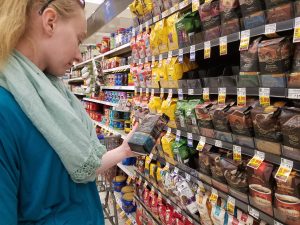It’s safe to say that during any conversation the notion of change will be brought up: “I remember when gas was only $1 a gallon.” “Most cars were standard transmissions, and now my car is going to drive ITSELF?” Some of us may or may not be familiar with these changes. But one change that affects us all is the change within our food. Whether you are a producer looking to stay afloat in a changing market or you are loading your cart up at the grocery store, we are ALL consumers.

If we are all consumers, then shouldn’t keeping up with changes in consumer demand be easy for producers? I mean, they can adapt right along with the market, right? Well, that may be the case if we all thought the same way and had the same preferences. Since there are numerous preferences and several production methods, how are consumers and producers supposed to be on the same page? Relationships. In a world where we can reach thousands of people via social media in a matter of minutes, everyone should know immediately when preferences shift and be able to adjust accordingly….well, not exactly.
Today, we are great at communicating, but how well do we converse? What’s the difference? On social media we communicate by displaying information about what we want or what we do, but this can leave that information open to different interpretations and lead to misconceptions about what consumers really want and what producers are actually doing. Sometimes this leads to more debate on who is right or wrong rather than allowing producers and consumers to work together. We all can do a better job of conversing to better understand each other’s ideas and practices. With so many different needs, ideas, and preferences, it may seem impossible to get everyone on the “same-page.” This is where Extension can play a huge role, and this is why I am so passionate about my job.
Recently, our team of Extension professionals has been conducting Beef Quality Assurance Trainings (BQA). I have been conducting these trainings with Brooke Beam of Highland County, Gigi Neal of Clermont County, and David Dugan of Adams County. At these trainings we converse about what consumer changes are developing and how we can meet those needs. We speak about practices that ensure producers can consistently provide a safe and wholesome product from start to finish. We also answer several questions about what consumers are wanting and what they are concerned about. A few Extension educators can’t answer all of the questions or tie up all of the loose-ends within the industry, but we give those who attend the ability to educate others and set good examples. Over the last three trainings we have trained close to 300 individuals.

Now that producers are being trained, how are consumers supposed to know what is going on within the industry and where their product is coming from? Just as a few educators cannot communicate with every producer, we cannot reach every consumer either. Companies such as Wendy’s and Tyson have helped serve as a voice for consumers by stating they will only accept beef from BQA certified producers. Wherever cattle are sold, producers will be able to prove they are BQA certified and follow the practices to provide a safe and high quality product. Consumers do not always get to meet the producer and discuss the product they are buying, but allowing everyone to become familiar with the guidelines of this certification will help bridge the gap between the unknown and serve as a common language for everyone. Even if several producers already implement these practices, the BQA certification can help pass on that information.
We are taking steps to build relationships in all areas of food production, not only within beef production. For example, in October the OSU Direct Food and Marketing Team along with the University of Kentucky Cooperative Extension Service will be visiting Brown County to discuss how producers can enter various markets. They will share more about what consumers are looking for and how they can build relationships in several different markets.

Picture credit: Clark’s Farm Produce and Meat.
As I talk about training producers to understand the needs of consumers, it is important too for us all to remember what I mentioned earlier. There are numerous preferences, and none is more right or wrong than another. There is no universal way to meet each other’s needs. This can only be understood through conversation. A group of Brown County families are making this happen after they formed the Buckeye Valley Beef Cooperative. This group provides locally grown beef to several grocers in Brown County as well as direct to consumer. The cooperative members stay in contact with the consumers and raise their product based on the demands of the surrounding communities.
As I get to work with the various producers and consumers, I notice there is not a refusal to work together but a stockpile of questions and misconceptions. There will always be a few bad eggs in almost any situation, but the good will always outweigh the bad. You hear plenty about the bad and the division between one another, but even more are working together to build relationships. Just as the changes I referenced earlier didn’t happen over night, we cannot expect this change to be any different. The importance to discuss our needs is not to prove a point or win an argument, but to create a better situation for those we care about. It doesn’t matter if you are caring for the family you have around the table or the animal you tend to everyday. We are all consumers and we all care for one another.
 James Morris is a County Extension Educator, Brown County.
James Morris is a County Extension Educator, Brown County.

 Government issued labels were created to: ensure fair competition among producers, provide consumers with basic product information, and most importantly to reduce health and safety risks
Government issued labels were created to: ensure fair competition among producers, provide consumers with basic product information, and most importantly to reduce health and safety risks
